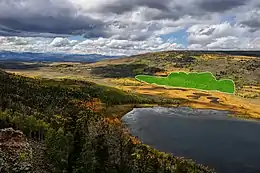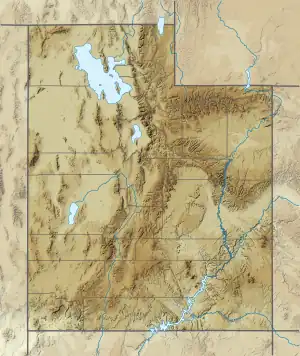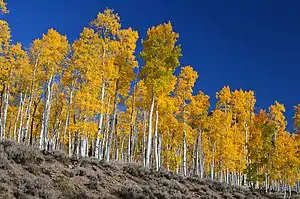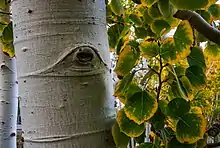| Pando | |
|---|---|
 Image of the approximate land mass of Pando shaded green | |
| Map | |
 Location in Utah  Location in the United States | |
| Geography | |
| Location | Fishlake National Forest, Utah, United States |
| Coordinates | 38°31′30″N 111°45′00″W / 38.52500°N 111.75000°W |
| Area | 108 acres (43.6 ha) |
| Administration | |
| Established | +14000 BP |
| Ecology | |
| Dominant tree species | Populus tremuloides |

Pando (Latin for "I spread")[1] is a clonal organism representing an individual male quaking aspen (Populus tremuloides) that spans 106 acres and is both the largest tree by weight and the largest tree by landmass, and is also the largest known aspen clone. Pando was identified as a single living organism because each of its estimated 47,000 stems (ramets) possesses identical genetic markers.[2] Each of the stems also is generally connected by a massive interconnected root system that coordinates energy production, defense and regeneration across its expanse.[3] Located in the Fremont River Ranger District of the Fishlake National Forest along the transition zone between of the Colorado Plateau and Basin and Range[4] in south-central Utah, United States, Pando lives 0.43 miles west of Fish Lake, the largest natural mountain freshwater lake in Utah.[5]
Pando occupies approximately 106 acres (43 ha) and is estimated to weigh collectively 6,000 tonnes (6,000,000 kg),[6] or 13.2 million pounds, making it the heaviest known organism.[7][8] While the terms "organism" or "plant" have been used to describe the superlative quality of the tree, Pando is an aspen clone, and colloquially, tree lovers simply call the botanical wonder the "Pando Tree". While the General Sherman Tree is the largest single stem tree, systems of classification to define the largest trees vary considerably, leading to some confusion about Pando's status in the tree world. For example, within the United States, the Official Register of Champion Trees defines the largest trees in a species specific way, in that case, Pando is the largest aspen tree (Populus tremuloides). In forestry, the largest trees are measured by the greatest volume of a single stem, regardless of species. No large tree classification exists today to qualify Pando's size as it is the largest aspen clone, largest tree by weight and land mass combined. While many emphasize that Pando is the largest clonal organism, Redwoods also can reproduce via cloning. In addition, many non-plants vie for that distinction. Some have stated Pando is the largest plant, however that distinction is owed to a sea grass colony in the South Pacific, Posidonia australis.
A recent discovery whose scale of operation was only verified in 2008, little is known about Pando's origins and how its genetic integrity has been sustained over such a long time (between 9,000 and 12,000 years). Researchers have argued that Pando’s future is also uncertain due to a combination of factors including drought, grazing, and fire suppression.[9][10]
Today, Friends of Pando,[11] the United States Forest Service, and researchers work together to study, monitor, and protect the tree.[12] Other organizations that study and work to study and protect Pando include Western Aspen Alliance[13] and Grand Canyon Trust[14] in the private sector, and the Utah Department of Wildlife Resources[15] in the governmental sector.
Discovery, naming and verification
The Pando tree was identified in 1976 by Jerry Kemperman and Burton Barnes.[16][17] In a posthumous biography by Burton Barnes' colleague, Daniel Kashian details the tree's discovery:
As a part of his aspen work in the West, Burt began to examine an extremely large trembling aspen clone southwest of Fish Lake, Utah, in the late 1960s and early 1970s. Using aerial photography and the same morphological differentiation techniques he developed for aspen at UMBS for his dissertation, Burt concluded that the aspen forest that covered about 106 acres was a single aspen clone, quite possibly the “world’s largest organism.” Other than a single publication about aspen clone size and another great story to tell his students, Burt’s studies on the Fish Lake clone were relatively obscure.
— Daniel M. Kashian, BURTON V. BARNES (1930–2014)
Work by Fishlake National Forest to understand and protect the tree began in 1987, according to interviews and articles written by Fishlake Forest as well as accounts gathered by Friends of Pando.[18] Based off of Barnes and Kempermans's 1976 paper, Michael Grant, Jeffrey Mitton, and Yan Linhart of the University of Colorado at Boulder re-examined the clone in 1992, naming it "Pando" and claiming it to be the world's largest organism by weight.[1] Both teams of researchers described Pando as a single male aspen clone based on its morphological characteristics such as pollen production, leaves, and root structure. A large scale genetic sampling and analysis was published in 2008 by Jennifer DeWoody of the US Forest Service, Carol Rowe, Valerie Hipkins, and Karen Mock of Utah State University, which confirmed previous morphological analysis by Barnes, Kemperman, Mitton Grant and Linhart and verified Pando was in fact a single clonal colony operating as one tree spreading out across a 106-acre expanse.[19]

Research and protection
In the late 1987, Fishlake National Forest began work to remove diseased trees and promote new growth on the yet-to-be-named tree using coppicing,[20] mechanical stimulation,[21] and ground fire to simultaneously remove diseased stems while stimulating regeneration.[22] In 1993, Fishlake National Forest began work on the "Aspen Regeneration Project",[23] installing fences to help control deer and elk who threatened to destroy the productive results of the regeneration project. Today, 53 acres of Pando is protected by 8-foot fences to control populations of mule deer (Odocoileus hemionus) and elk (Cervus canadensis), and to control human use, such as permitted grazing by domestic cattle (Bos taurus).
Regeneration rates in portions of the "Aspen Regeneration Project" which started in the 1990's, and was expanded in 2014 showed promise based on photographic evidence and repeated survey plots by land managers, scientists and conservation groups between 1993 and today.[24] Despite this, many have argued more work needs to be done to control wildlife, as Pando is surrounded by 700 square miles of defacto wildlife preserve managed by people, groups and agencies who do not have Pando's sustainability as a central concern in their land management policies. Paul Rogers and Darren McAvoy of Utah State University completed an assessment of Pando's status in 2018 and stressed the importance of reducing herbivory by mule deer as critical to conserving Pando for the future.[10] In 2019, Rogers and Jan Šebesta surveyed other vegetation within Pando besides aspen, finding additional support for their 2018 conclusion that interactions between browsing and past and ongoing management may have had adverse effects on Pando's long-term resilience to change.[25] In 2023, a team of researchers, land managers, wildlife biologists and citizen scientists groups began long term programs to monitor deer and elk using GPS collars and wildlife cameras to better understand wildlife browsing on the tree.[26]
Size and age
Most agree, based on Barnes' work and later work, that Pando encompasses 42.89 hectares (106 acres), weighs an estimated 6,000 metric tons (6,600 short tons) or 13.2 million pounds, and features an estimated 47,000 stems, which die individually and are replaced by genetically identical stems that are sent up from the tree's vast root system, a process known as "suckering".[2][5] The root system is estimated to be several thousand years old, with habitat modeling suggesting a maximum age of 14,000 years.[27][28] Individual stems do not typically live more than 100–130 years.
Mitton and Grant summarize the development of stems in aspen clones:[7]
... quaking aspen regularly reproduces via a process called suckering. An individual stem can send out lateral roots that, under the right conditions, send up other erect stems; from all above-ground appearances the new stems look just like individual trees. The process is repeated until a whole stand, of what appear to be individual trees, forms. This collection of multiple stems, called ramets, all form one, single, genetic individual, usually termed a clone.
Range of age estimates
Due to the progressive replacement of stems and roots, the overall age of an aspen clone cannot be determined from tree rings. In Pando's case, ages up to 1 million years have therefore been suggested.[7] An age of 80,000 years is often given for Pando, but this claim derives from a now-removed National Park Service web page, which redacted that claim in 2023 and was inconsistent with the Forest Service's post ice-age estimate.[29] Glaciers repeatedly formed on the Fish Lake Plateau[30] over the past several hundred thousand years and the Fish Lake Basin occupied by Pando was partially filled by ice as recently as the last glacial maximum.[31] Ages greater than approximately 16,000 years therefore require Pando to have survived at least the Pinedale glaciation, something that appears unlikely under current estimates of Pando's age and modeling of variation in Pando's local climate.[27][28]
Estimates of Pando's age have also been influenced by changes in the understanding of establishment of aspen clones in western North America. Earlier sources argued germination and successful establishment of aspen on new sites was rare in the last 10,000 years and therefore, Pando's root system was likely over 10,000 years old.[7] More recent observations, however, have shown seedling establishment of new aspen clones is a regular occurrence and can be abundant on sites exposed by wildfire.[32] These findings are summarized in the U.S. Forest Service's Fire Effects Information System:[33]
Kay documented post-fire quaking aspen seedling establishment following 1986 and 1988 fires in Grand Teton and Yellowstone National Parks, respectively. He found seedlings were concentrated in kettles and other topographic depressions, seeps, springs, lake margins, and burnt-out riparian zones. A few seedlings were widely scattered throughout the burns. In Grand Teton National Park, establishment was greatest (950–2,700 seedlings/ha) in 1989, a wet year, but hundreds to thousands of seedlings established each year despite drought conditions in 1986–1988 and 1990–1991. Seedlings surviving past one season occurred almost exclusively on severely burned surfaces.
Pando in popular culture
- In 2006, the United States Postal Service published a stamp in commemoration of the aspen, calling it one of the forty "Wonders of America".[34][35]
- In 2013, Pando featured as the backdrop and the subject of a music video for a successful campaign led by 4th graders of nearby Monroe, Utah, United States, to have the State of Utah's Tree be changed from Colorado Spruce to the Quaking Aspen.[36][37] The song the children sang was written by Utah folk artist and songwriter, Clive Romney.[38]
- In 2018, the Pando Aspen Clone figures as a central figure in the life of the character Patricia Westerford in Richard Powers' novel "The Overstory".[39]
- The 2022 Disney film "Strange World" has a creature named "Pando"[40] which bears similarities with the actual Pando Tree.
- In 2022, an episode of NBC TV Show "The Blacklist" entitled "The Trembling Giant"[41] (a nickname for Pando) features a scene where central character Raymond 'Red' Reddington details the tree's operation.[42]
- In 2022, Friends of Pando published audio works by sound conservationist and artist Jeff Rice documenting the tree's subterranean workings for the first time.[43] [44][45]
- In 2022, Pando was the subject of an issue of the webcomic xkcd published on December 23 (two days before Christmas), which facetiously suggests adding to Pando's many world records that of world's largest Christmas tree by running a 9,300-foot-long string of Christmas lights through the branches along its perimeter.[46]
See also
References
- 1 2 Grant, Michael C. (October 1993). "The Trembling Giant". Discover. Vol. 14, no. 10. Chicago. pp. 82–89. Retrieved 2008-05-08.
- 1 2 DeWoody, Jennifer; Rowe, Carol A.; Hipkins, Valerie D.; Mock, Karen E. (2008). ""Pando" Lives: Molecular Genetic Evidence of a Giant Aspen Clone in Central Utah". Western North American Naturalist. 68 (4): 493–497. doi:10.3398/1527-0904-68.4.493. S2CID 59135424.
- ↑ "Frequently asked questions about the World's Largest Tree". Friends of Pando. Retrieved 2023-10-31.
- ↑ "Basin and Range Province", Wikipedia, 2023-09-27, retrieved 2023-10-31
- 1 2 "Pando". USDA Forest Service. Retrieved 2013-08-24.
- ↑ OECD (2000). Consensus Document on the Biology of Populus L. (Poplars) (PDF). Series on Harmonization of Regulatory Oversight in Biotechnology. Vol. 16. Paris: Organisation for Economic Co-operation and Development. Retrieved 2018-11-17.
- 1 2 3 4 Mitton, Jeffry B.; Grant, Michael C. (1996). "Genetic Variation and the Natural History of Quaking Aspen". BioScience. 46 (1): 25–31. doi:10.2307/1312652. JSTOR 1312652.
- ↑ Mihai, Andrei (February 9, 2015). "The Heaviest Living Organism in the World". ZME Science. Retrieved 2015-02-12.
- ↑ Rogers, Paul C.; Gale, Jody A. (2017). "Restoration of the iconic Pando aspen clone: Emerging evidence of recovery". Ecosphere. 8 (1): 1–15. doi:10.1002/ecs2.1661.
- 1 2 Rogers, Paul C.; McAvoy, Darren J. (2018-10-17). "Mule deer impede Pando's recovery: Implications for aspen resilience from a single-genotype forest". PLOS ONE. 13 (10): 1–19. Bibcode:2018PLoSO..1303619R. doi:10.1371/journal.pone.0203619. ISSN 1932-6203. PMC 6192553. PMID 30332420.
- ↑ "Friends of Pando". Friends of Pando. Retrieved 2023-11-02.
- ↑ Harkins, Paighten (August 14, 2023). "Once given a death sentence, Utah's Pando aspen grove has 'come a long way'". The Salt Lake Tribune. Retrieved December 20, 2023.
- ↑ University, Utah State. "Western Aspen Alliance". qcnr.usu.edu. Retrieved 2023-11-02.
- ↑ "Pando Clone Recovery". Grand Canyon Trust. 2020-03-05. Retrieved 2023-11-02.
- ↑ "How can tracking deer benefit Fishlake National Forest's Pando clone?". Retrieved 2023-11-02.
- ↑ Kemperman, Jerry A.; Barnes, Burton V. (1976-11-15). "Clone size in American aspens". Canadian Journal of Botany. 54 (22): 2603–2607. doi:10.1139/b76-280. ISSN 0008-4026. S2CID 85891968.
- ↑ Mock, K. E.; Rowe, C. A.; Hooten, M. B.; Dewoody, J.; Hipkins, V. D. (2008). "Clonal dynamics in western North American aspen (Populus tremuloides)". Molecular Ecology. 17 (22): 4827–4844. doi:10.1111/j.1365-294X.2008.03963.x. PMID 19140975. S2CID 1425039. Archived from the original on 2018-09-19. Retrieved 2018-11-17.
- ↑ "History of Land Management in Pando". Friends of Pando. Retrieved 2023-10-31.
- ↑ DeWoody, Jennifer; Rowe, Carol A.; Hipkins, Valerie D.; Mock, Karen E. (December 2008). ""Pando" Lives: Molecular Genetic Evidence of a Giant Aspen Clone in Central Utah". Western North American Naturalist. 68 (4): 493–497. doi:10.3398/1527-0904-68.4.493. ISSN 1527-0904.
- ↑ "Coppicing", Wikipedia, 2023-09-30, retrieved 2023-10-31
- ↑ Shepperd, Wayne D. (2001). "Manipulations to regenerate aspen ecosystems". In: Shepperd, Wayne D.; Binkley, Dan; Bartos, Dale L.; Stohlgren, Thomas J.; Eskew, Lane G., comps. Sustaining aspen in western landscapes: Symposium proceedings; 13-15 June 2000; Grand Junction, CO. Proceedings RMRS-P-18. Fort Collins, CO: U.S. Department of Agriculture, Forest Service, Rocky Mountain Research Station. p. 355-366. 18: 355–366.
- ↑ "History of Land Management in Pando". Friends of Pando. Retrieved 2023-11-02.
- ↑ "History of Land Management in Pando". Friends of Pando. Retrieved 2023-10-31.
- ↑ "Pando Clone Recovery". Grand Canyon Trust. 2020-03-05. Retrieved 2023-11-15.
- ↑ Rogers, Paul C.; Šebesta, Jan (December 2019). "Past Management Spurs Differential Plant Communities within a Giant Single-Clone Aspen Forest". Forests. 10 (12): 1118. doi:10.3390/f10121118.
- ↑ "Once given a death sentence, Utah's Pando aspen grove has 'come a long way'". The Salt Lake Tribune. Retrieved 2023-10-31.
- 1 2 Mock, K. E.; Rowe, C. A.; Hooten, M. B.; Dewoody, J.; Hipkins, V. D. (November 2008). "Clonal dynamics in western North American aspen ( Populus tremuloides )". Molecular Ecology. 17 (22): 4827–4844. doi:10.1111/j.1365-294X.2008.03963.x. PMID 19140975. S2CID 1425039.
- 1 2 Ding, Chen; Schreiber, Stefan G.; Roberts, David R.; Hamann, Andreas; Brouard, Jean S. (2017-07-05). "Post-glacial biogeography of trembling aspen inferred from habitat models and genetic variance in quantitative traits". Scientific Reports. 7 (1): 4672. Bibcode:2017NatSR...7.4672D. doi:10.1038/s41598-017-04871-7. ISSN 2045-2322. PMC 5498503. PMID 28680120.
- ↑ United States Forest Service, Fishlake National Forest. "Pando - (I Spread)".
- ↑ "A Geologic History of Fishlake, Pando's Home". Friends of Pando. Retrieved 2023-11-15.
- ↑ Marchetti, David W.; Harris, M. Scott; Bailey, Christopher M.; Cerling, Thure E.; Bergman, Sarah (January 2011). "Timing of glaciation and last glacial maximum paleoclimate estimates from the Fish Lake Plateau, Utah". Quaternary Research. 75 (1): 183–195. Bibcode:2011QuRes..75..183M. doi:10.1016/j.yqres.2010.09.009. ISSN 0033-5894. S2CID 128684169.
- ↑ Kay, Charles E. (1993). "Aspen seedlings in recently burned areas of Grand Teton and Yellowstone National Parks" (PDF). Northwest Science. 67 (2): 94–104.
- ↑ Howard, Janet L. (1996). "Populus tremuloides". Fire Effects Information System. U.S. Department of Agriculture, Forest Service, Rocky Mountain Research Station, Fire Sciences Laboratory. Retrieved 2018-11-17.
- ↑ Sussman, Rachel (2014). "Pando". The Oldest Living Things in the World. University of Chicago Press. p. 59. doi:10.7208/chicago/9780226057644.001.0001. ISBN 978-0-226-05764-4.
- ↑ "Wonders of America: Land of Superlatives". Archived from the original on 2 December 2008.
- ↑ Utah's State Tree: The Quaking Aspen, by Monroe Elementary, retrieved 2023-10-31
- ↑ March 26, Benjamin Wood | Posted-; P.m, 2014 at 9:45. "Utah state tree changes thanks to elementary students". www.ksl.com. Retrieved 2023-10-31.
{{cite web}}: CS1 maint: numeric names: authors list (link) - ↑ "Clive Romney: Mormon Musician - Mormonism, The Mormon Church, Beliefs, & Religion - MormonWiki". www.mormonwiki.com. Retrieved 2023-10-31.
- ↑ "The Overstory", Wikipedia, 2023-07-25, retrieved 2023-10-31
- ↑ "Strange World (film)", Wikipedia, 2023-10-27, retrieved 2023-10-31
- ↑ Watch The Blacklist Clip: The Trembling Giant | NBC's The Blacklist - NBC.com, retrieved 2023-10-31
- ↑ "James Spader", Wikipedia, 2023-10-18, retrieved 2023-10-31
- ↑ "Pando's voice: Unveiling the acoustic wonders of Southern Utah's most famous tree". Retrieved 2023-10-31.
- ↑ "The Sweet Song Of The Largest Tree On Earth". Science Friday. Retrieved 2023-10-31.
- ↑ Listening to the Largest Tree on Earth, retrieved 2023-10-31
- ↑ "xkcd: Pando". xkcd. 2021-12-23. Retrieved 2023-12-09.
Additional references
- Barnes, Burton V. (1966). "The Clonal Growth Habit of American Aspens". Ecology. 47 (3): 439–447. doi:10.2307/1932983. JSTOR 1932983.
- Barnes, Burton V. (1975). "Phenotypic variation of trembling aspen in western North America". Forest Science. 21 (3): 319–328. doi:10.1093/forestscience/21.3.319 (inactive 1 August 2023).
{{cite journal}}: CS1 maint: DOI inactive as of August 2023 (link) - Einspahr, Dean W.; Winton, Lawson L. (1977) [1976]. Genetics of quaking aspen. Research Paper. Vol. WO-25. USDA Forest Service.
- Kemperman, Jerry A.; Barnes, Burton V. (1976). "Clone size in American aspens". Canadian Journal of Botany. 54 (22): 2603–2607. doi:10.1139/b76-280.
- McDonough, W.T. (1985). "Sexual reproduction, seeds and seedlings". In DeByle, N.V.; Winokur., R.P. (eds.). Aspen: ecology and management in the western United States. Gen. Tech. Rep. Vol. RM-119. Fort Collins, CO: USDA Forest Service. pp. 25–28.
External links
 Media related to Pando (tree) at Wikimedia Commons
Media related to Pando (tree) at Wikimedia Commons- Pando at Atlas Obscura
- Friends of Pando "A Guide to All Things Pando"